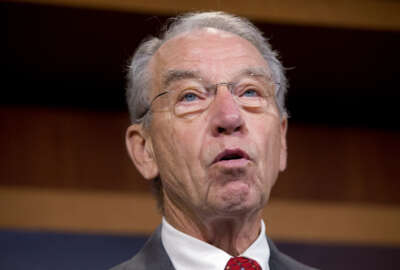
Feds get new administrative leave policy in 2017 NDAA
A provision in the 2017 National Defense Authorization creates new categories of administrative leave: "investigative" or "notice" leave. Employees under an adverse...
Federal employees will see new limits in 2017 to the number days they can spend on administrative leave, and agencies will be on a tighter timeline to finish personnel investigations that often stretch on for six to 18 months or longer.
Congress included a new policy on administrative leave in the 2017 National Defense Authorization Act, which passed Thursday afternoon. And at more than 1,500 pages, civilian employees will find plenty of other tidbits for themselves in the 2017 NDAA.
Specifically, the provision creates new categories — called investigative or notice leave — for employees who are under agency investigation or awaiting an adverse action decision and need to be out of the office. It also caps employees on investigative or notice leave to 10 work days in a given calendar year.
Agencies should place their employees on leave while the investigation is ongoing and if having the worker in the office “pose[s] a threat to the employee or others, result[s] in the destruction of evidence related to the investigation, result[s] in the loss of or damage to government property … or jeopardize[s] legitimate government interests,” the provision said.
Once an agency places an employee on leave for 10 days and determines that it needs more time to finish the personnel investigation, the employee will receive another 30 work days of leave.
Agencies can extend an employee’s leave no more than three times; extensions cannot exceed 90 work days in total. The provision also describes a specific process that agencies must go through to explain the reasons for a worker’s leave placement and any extensions throughout the investigation process.
In addition, an agency may ask an employee on investigative leave to perform similar work duties through telework.
The Office of Personnel Management, as well as each agency, must revise their own internal procedures within the next 270 days to reflect the new changes to administrative change, the NDAA said.
“Paying government employees to stay at home not only robs taxpayers, it allows agencies to drag their feet in disciplinary action,” Sen, Ron Johnson (R-Wis.), chairman of the Homeland Security and Governmental Affairs Committee, said in a statement on the 2017 NDAA. “This commonsense legislation will save taxpayers millions of dollars every year.”
Agencies spent a total of $3.1 billion on paid administrative leave between fiscal 2011-13, according to a 2014 Government Accountability Office study, and agencies’ interpretation and use of existing administrative leave authorities varied widely in the past.
The Senate version of this legislation came out of Johnson’s committee, which had Sens. Chuck Grassley (R-Iowa) and Jon Tester (D-Mont.) as sponsors.
House Oversight and Government Reform Committee Chairman Jason Chaffetz (R-Utah) championed this legislation in his chamber.
The provision also creates the category of “weather and safety leave,” for employees who cannot travel or perform their work safely due to a variety of conditions, such as a terrorist attack or weather event.
The Senior Executives Association praised lawmakers’ collaboration in crafting leave reform.
“The misuse of extended administrative leave has a significant impact on the efficiency and effectiveness of departments and agencies, in addition to its infringement on employees’ due process rights,” SEA President Bill Valdez said in a statement. “This provision will curb that unnecessary waste of taxpayer resources so the government can continue to best provide its services for the American public.”
The NDAA also includes a provision that targets members of the civil or excepted service involved in a personnel review who resign or retire from government before their agencies complete the investigation.
It requires agency leaders to include any adverse findings of the investigation in the employee’s personnel file. Agency heads have 40 days after the end of the review to include findings in the employee’s file and must notify the former employee of the results, the provision said.
The employee will then have 30 days to respond or provide evidence as to why the investigation’s conclusion was unfounded, and those documents would also appear in his or her personnel file.
Employees may also appeal the decision to the Merit Systems Protection Board, the provision said.
This provision stemmed from a piece of legislation that Chaffetz introduced in January. It specifically responds to a trend that lawmakers say has become more common in recent years.
For example, Susan Taylor, a former Veterans Affairs Department executive at the center of the reverse auction procurement scandal, retired in October 2014, three weeks after a VA inspector general investigation found that she had allegedly committed procurement fraud.
Chaffetz praised the inclusion of both administrative leave reform and the additional provisions on employees’ official personnel files.
“The vast majority of federal workers are honest, hardworking Americans who proudly serve country,” he said in a Dec. 8 statement. “But, as in most large groups, there are some bad apples. Together, these bills help curb costly and unfair abuses taken by misbehaving employees.”
A third provision in the NDAA also clarifies what kinds of permanent jobs temporary employees at land management agencies can compete for under “internal merit promotion procedures.”
Specifically, employees in a time-limited appointment can compete for opportunities at land management agency when that organization opens the job within its own workforce or any agency that accepts applications from anyone.
The provision appears to address an issue the National Federation of Federal Employees had with the OPM’s interpretation of the Land Management Workforce Flexibility Act.
It applied to temporary employees at the Bureau of Land Management, National Park Service, Fish and Wildlife Service, Bureau of Indian Affairs and Bureau of Reclamation.
Copyright © 2025 Federal News Network. All rights reserved. This website is not intended for users located within the European Economic Area.
Nicole Ogrysko is a reporter for Federal News Network focusing on the federal workforce and federal pay and benefits.
Follow @nogryskoWFED





